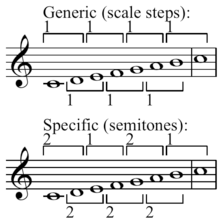Maximal evenness


In diatonic set theory, maximal evenness is a quality of a collection or scale in which every generic interval has either one or two consecutive (adjacent) specific intervals—in other words a scale that is "spread out as much as possible." This property was first described by music theorist John Clough and mathematician Jack Douthett in "Maximally Even Sets" (1991). (Johnson 2003, p.27, 150)
Myhill's property, that there are two specific intervals for every generic interval, follows from maximally evenness, and both properties are true of the diatonic collection, for instance adjacent notes are separated only by half-tones and whole-tones (1 and 2). The whole-tone scale is also maximally even, as its adjacent notes are separated only by whole-tones.
Richard J. Krantz and Jack Douthett[1] propose spectra variations as a way to quantify and compare the evenness of distributions.
Second-order maximal evenness is maximal evenness of a subcollection of a larger collection that is maximally even. Diatonic triads and seventh chords possess second-order maximal evenness, being maximally even in regard to the maximally even diatonic scale—but are not maximally even with regard to the chromatic scale. (ibid, p.115) This nested quality resembles Fred Lerdahl's "reductional format" for pitch space from the bottom up:
| C | E | G | C | |||||||||
| C | D | E | F | G | A | B | C | |||||
| C | D♭ | D | E♭ | E | F | F♯ | G | A♭ | A | B♭ | B | C |
- (Lerdahl, 1992)
The musical theory of maximal evenness has been used as part of the Ising model in physics to model electron behavior. (Johnson 2003, p.144).
In a dynamical approach, spinning concentric circles and iterated maximally even sets have been constructed as an alternate approach to Riemann theory. This approach leads to some interesting connections between diatonic and chromatic theory. (Douthett, 2008)
Distributional evenness
Distributional evenness is a property of musical scales. A scale is distributionally even if for each generic interval there are one or two specific intervals (Xenharmonic Wiki).
Generating maximally even sets
Emmanuel Amiot [2] presents “the most effective way to actually compute ME sets.” Here is a simplified implementation in the GNU Octave programming language (with c as the cardinality of the ambient chromatic space, and d the number of notes of the looked-for set)[3]:
function ret = maxeven(c,d) ret = floor ([0:(d-1)].*c./d); endfunction
Further reading
- Clough, John and Douthett, Jack (1991). "Maximally Even Sets", Journal of Music Theory 35: 93-173.
- Douthett, Jack and Krantz, Richard (2007). "Maximally Even Sets and Configurations: Common Threads in Mathematics, Physics, and Music", Journal of Combinatorial Optimization 14: 385-410.
- Douthett, Jack and Krantz, Richard (2008). "Dinner Tables and Concentric Circles: A Harmony in Mathematics, Music, and Physics", College Mathematics Journal 39: 203-211.
Sources
- Johnson, Timothy (2003). Foundations of Diatonic Theory: A Mathematically Based Approach to Music Fundamentals. Key College Publishing. ISBN 1-930190-80-8.
- Lerdahl, Fred (1992). "Cognitive Constraints on Compositional Systems", Contemporary Music Review 6 (2), pp. 97-121.
- Douthett, Jack (2008). "Filter Point-Symmetry and Dynamical Voice-Leading", Music Theory and Mathematics: Chords, Collections, and Transformations (Eastman Studies in Music):72-107. Ed. J. Douthett, M. Hyde, and C. Smith. University of Rochester Press. ISBN 1-58046-266-9.
- "Distributional+Evenness", Xenharmonic.Wikispaces.com.